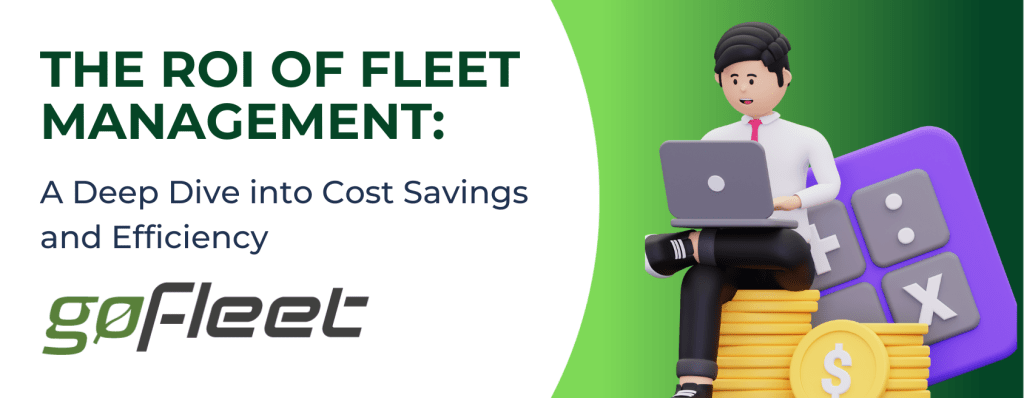The ROI of Fleet Management: Cost Savings and Efficiency
Return on Investment (ROI) is the beacon guiding strategic decisions within an enterprise. For fleet managers, understanding the ROI of fleet management is not just about justifying expenditures; it’s about substantiating the value that each vehicle and driver brings to the company’s bottom line.
Without a clear picture of ROI, fleet-related decisions can be guesswork at best and financially detrimental at worst. Accurate ROI calculations enable fleet managers to:
- Validate the effectiveness of their strategies.
- Make informed decisions about asset acquisition and disposal.
- Optimize operational processes to boost profitability.
- Secure budget and investments by demonstrating financial prudence.
Effective fleet management wields the power to unlock significant cost savings and efficiency gains. By focusing on areas such as fuel consumption, vehicle maintenance, driver productivity, and compliance, businesses can not only reduce expenses but also elevate service quality, safety, and reliability. Potential cost savings can be transformative, leading to:
- Lower operational costs through optimized routes and improved fuel management.
- Reduced maintenance expenses by adopting predictive maintenance schedules.
- Enhanced productivity with the aid of advanced fleet management software.
The measure of ROI extends beyond mere number crunching—it becomes a strategic tool to gauge the health and productivity of a vital component of their operations. In this article, we’ll drill down on how the right fleet management strategy can save your operations time and money while improving workflows and optimizing your business.
Understanding Fleet Management ROI
ROI is not just a financial metric but a multidimensional indicator of performance. To truly grasp its essence, one must consider both the tangibles and intangibles that constitute the total return on investment in fleet operations.
What Constitutes ROI for Fleet Management
Through this lens, ROI accounts for various facets of fleet operations. It’s not solely the direct profits earned from fleet services but also encompasses cost avoidance, enhanced productivity, and improved service levels. The formula is straightforward: subtract the total fleet operational costs from the total fleet benefits, then divide by the total fleet costs and multiply by 100 to get a percentage. This result represents the ROI of fleet management, reflecting the effectiveness and efficiency of fleet operations in monetary terms.
Financial and Operational Factors Affecting ROI
Several key factors affect the ROI of fleet management, each playing a significant role in the overall financial health of fleet operations:
- Cost Savings: This includes reductions in fuel consumption, maintenance expenses, and administrative costs, which directly improve the bottom line.
- Asset Utilization: Maximizing the use of each vehicle ensures that the fleet is not overcapitalized and that each asset contributes to revenue generation.
- Lifecycle Management: By extending the useful life of fleet assets through proactive maintenance and strategic replacement, companies can enhance their ROI.
- Revenue Enhancement: Effective fleet management can also lead to improved customer satisfaction and retention, which translates into increased revenue streams.
- Operational Efficiency: Streamlined operations and reduced downtime contribute to a more efficient fleet, thereby impacting ROI positively.
- Technology Investment: The adoption of fleet management software and telematics can lead to significant efficiencies and cost savings over time.
Short-Term Gains Versus Long-Term Value
When evaluating ROI, it’s critical to differentiate between short-term gains and long-term value. Short-term gains may come from immediate cost-cutting measures, but these can sometimes lead to higher costs down the line if they result in increased vehicle downtime or reduced service quality. On the other hand, investments that may have a lower ROI in the short term, like advanced training for drivers or the implementation of fleet management systems, often lead to significant long-term value through increased safety, reduced risk, and enhanced reputation.
Understanding the ROI of fleet management requires a balance between immediate financial benefits and the strategic long-term value that sustainable practices bring. It is about looking beyond the horizon of immediate returns and recognizing the enduring benefits that wise investments in fleet management can yield.
Key Areas Where Fleet Management Drives ROI
For fleet-dependent businesses, strategic fleet management is instrumental in driving ROI. By scrutinizing and optimizing certain key areas, organizations can significantly enhance their financial outcomes. Let’s explore these crucial segments where proficient fleet management catalyzes a substantial return on investment.
Fuel Management: Streamlining Consumption and Costs
Fuel expenses often constitute one of the largest components of fleet operational costs. Effective fuel management can lead to considerable savings and a higher ROI through:
- Fuel Consumption Tracking: Implementing systems to monitor fuel usage can identify patterns and anomalies, leading to more informed decisions.
- Fuel-Efficient Practices: Training drivers on eco-driving techniques and implementing policies that reduce idling can cut fuel costs substantially.
- Vehicle Selection: Choosing the right vehicles with better fuel economy tailored to specific tasks can lead to long-term fuel savings.
Vehicle Maintenance: Preserving Asset Value and Minimizing Repairs
Proactive vehicle maintenance is vital for extending the lifespan of fleet vehicles and preventing costly repairs:
- Preventive Maintenance Schedules: Regularly scheduled check-ups can prevent major breakdowns and extend vehicle longevity, thus protecting the fleet’s value.
- Condition-Based Monitoring: Utilizing telematics to monitor vehicle health in real-time allows for timely interventions, thereby reducing the need for extensive repairs.
- Vendor Management: Establishing relationships with quality maintenance providers can ensure competitive pricing and consistent service quality.
Driver Productivity: Enhancing Efficiency Through Smart Routing
The productivity of drivers directly influences fleet ROI, with route optimization being a key factor:
- Optimal Route Planning: Advanced routing software can determine the most efficient routes, reducing travel time and increasing the number of deliveries or service calls.
- Driver Training: Equipping drivers with the knowledge to handle real-world scenarios efficiently can lead to more on-time deliveries and less wasted labor.
- Incentive Programs: Implementing incentive programs that reward efficient and safe driving can motivate drivers to be more productive and cost-conscious.
Compliance and Fines: Mitigating Risk and Unnecessary Expenditure
Staying on top of regulatory requirements is not only a legal mandate but also a financial safeguard:
- Compliance Software: Leveraging software that keeps track of regulatory changes and automates compliance processes can save on administrative costs and avoid penalties.
- Regular Audits: Conducting periodic audits can ensure that all fleet activities are within regulatory parameters, mitigating the risk of fines.
- Driver Education: Keeping drivers informed about compliance standards can prevent violations that lead to fines and legal costs.
In these areas, the advantages of investing in fleet management can be quantified not only in direct cost savings but also in the avoidance of potential losses and the enhancement of service quality. By prioritizing these key areas, organizations can significantly bolster their ROI, reinforcing the notion that prudent fleet management is an investment worth making.
Technology’s Impact on Fleet Management ROI
In the digital age, technology stands as a cornerstone in the quest for maximized ROI in fleet management. Its ability to streamline operations, provide actionable insights, and improve decision-making is unparalleled. Let’s examine the multifaceted role technology plays in enhancing fleet management ROI.
Fleet Management Software: A Hub for ROI Enhancement
Fleet management software has revolutionized how fleet operations are monitored, analyzed, and optimized. These sophisticated platforms offer a significant number of features that contribute to ROI:
- Centralized Control: Simplifies management by providing a unified view of the entire fleet, leading to better coordination and resource allocation.
- Automated Processes: From scheduling maintenance to route planning, automation reduces the need for manual intervention, cutting down administrative costs.
- Data Analytics: Offers detailed reports on fleet performance, enabling managers to make data-driven decisions that can drive down costs and improve efficiency.
Telematics and Real-Time Data: The Game Changers
The integration of telematics has provided a real-time window into fleet operations, offering a multitude of benefits:
- Real-Time Tracking: Allows for the optimization of routes, reducing fuel consumption and ensuring timely deliveries.
- Predictive Maintenance: By anticipating vehicle maintenance needs, telematics help prevent costly breakdowns and extend vehicle life.
- Driver Behavior Monitoring: Encourages safer driving habits, which can reduce accidents, lower insurance premiums, and improve vehicle longevity.
Measuring and Tracking ROI in Fleet Management
Accurately measuring and tracking ROI is pivotal for understanding the effectiveness of fleet management strategies. This evaluation helps in making informed decisions, justifying investments, and identifying areas for enhancement. Let’s explore the means by which enterprises can calculate, benchmark, and consistently ameliorate their ROI.
Tools and Methodologies for Precise ROI Calculation
Calculating ROI in fleet management involves complex variables and requires a detailed understanding of both direct and indirect costs. Tools and methodologies that can be employed include:
- ROI Calculation Formulas: Utilizing the basic ROI formula [(Financial Gain – Cost of Investment) / Cost of Investment] and adapting it to include fleet-specific metrics such as cost per mile, vehicle utilization rates, and cost of vehicle downtime.
- Fleet Management Software: These platforms often come with built-in analytics that can track the performance metrics necessary to understand ROI, providing an automated and accurate assessment.
- Total Cost of Ownership (TCO) Models: Assessing all costs related to fleet operations over the life of a vehicle, including purchase price, fuel, maintenance, insurance, and resale value, to inform the ROI analysis.
Benchmarking and Setting Realistic ROI Expectations
To gauge the success of fleet management investments, businesses must:
- Establish Baselines: Determine the current performance levels to measure improvements against, providing a clear picture of progress.
- Industry Benchmarking: Compare performance with industry standards to set realistic ROI goals and to understand where the fleet stands in the competitive landscape.
- Adjust for External Factors: Consider external variables such as fuel price volatility or regulatory changes that may affect ROI, and adjust expectations accordingly.
Strategies for Continuous ROI Monitoring and Enhancement
A dynamic approach to ROI involves not just one-time calculation but ongoing monitoring and iterative improvement:
- Regular Reporting: Schedule periodic reviews of fleet performance data to keep track of ROI and identify trends.
- Continuous Improvement Process: Implement a framework for continual assessment and optimization of fleet management strategies to enhance ROI over time.
- Employee Engagement: Involve drivers and other stakeholders in the process to identify inefficiencies and encourage behaviors that contribute to better ROI.
By leveraging these tools and strategies, enterprises can establish a robust process for measuring and tracking ROI. This process serves as a foundational element in the strategic management of fleet operations, ensuring that each decision is aligned with the ultimate goal of maximizing returns. With diligent application, the insights gained from ROI assessments can lead to ongoing improvements, driving the fleet towards greater profitability and success.
Challenges in Maximizing Fleet Management ROI
Achieving a high ROI in fleet management is not without its hurdles. Various obstacles can impede the efficiency and cost-effectiveness of fleet operations. Recognizing these challenges is the first step toward overcoming them and securing a stronger ROI.
Some of the most common obstacles to high ROI can include:
- Rising Fuel Costs: Fluctuating fuel prices can significantly affect operational costs and, consequently, ROI.
- Vehicle Depreciation: As fleet vehicles are assets that depreciate over time, managing this loss of value is critical to maintaining ROI.
- Regulatory Compliance: Staying abreast of and adhering to evolving regulations can impose financial and operational burdens on fleets.
- Maintenance Overheads: Unscheduled maintenance and repairs can cause unexpected expenses and downtime, hurting ROI.
- Driver Behavior: Inefficient driving habits can lead to increased fuel consumption, accidents, and insurance claims, all of which detract from ROI.
- Technological Adaptation: The fast pace of technological change requires continuous investment, and the benefits may not always be immediate.
Overcoming the Challenges
To surmount these challenges, fleet managers can employ several strategies:
- Fuel Management Programs: Implement fuel-efficient driving practices and monitor fuel consumption to manage and mitigate the impact of rising fuel costs.
- Lifecycle Management: Establish a comprehensive vehicle lifecycle management strategy that considers the optimal time for vehicle replacement to balance depreciation and operational efficiency.
- Compliance Software: Utilize fleet compliance software to ensure regulations are met efficiently, thereby avoiding costly fines and downtime.
- Preventive Maintenance: Implement a preventive maintenance schedule to reduce the likelihood and cost of unscheduled repairs.
- Driver Training: Invest in driver training programs that promote safe and fuel-efficient driving practices.
- Cost-Benefit Analysis for Tech: Carefully evaluate the ROI of new technologies before implementation and keep abreast of innovations that can offer genuine value enhancements.
The landscape of fleet management is one of constant change and requires a proactive approach to maintain and improve ROI. By anticipating and adapting to these challenges, fleet managers can ensure that their operations remain efficient, compliant, and financially sound.
Implementing Best Practices for Enhanced ROI
To ensure that the ROI from fleet management aligns with the larger objectives of an enterprise, it is crucial to implement best practices systematically. The following section outlines strategic tips and recommendations to help enterprises maximize their fleet management ROI and synchronize these strategies with overarching business goals.
Tips for Maximizing Fleet Management ROI
- Lifecycle Management: Adopt a lifecycle approach to managing fleet assets, which involves understanding and managing the costs associated with each phase of a vehicle’s lifecycle, from acquisition to disposal.
- Total Cost of Ownership (TCO): Evaluate vehicles based on TCO, not just the purchase price. This includes costs like fuel, maintenance, insurance, and depreciation.
- Technology Adoption: Embrace technology such as telematics, GPS tracking, and fleet management software to gather data on vehicle usage, which can inform cost-saving decisions.
- Fuel Management Strategies: Implement fuel management strategies such as bulk purchasing, fuel card programs, and encouraging economical driving behaviors to reduce one of the most significant fleet expenses.
- Regular Maintenance and Upkeep: Establish a stringent maintenance regime to prevent costly breakdowns and extend vehicle longevity, thereby safeguarding against unforeseen expenses.
- Optimize Fleet Size: Regularly review fleet size and composition to ensure it meets current business needs without surplus, which can lead to unnecessary costs.
Aligning Fleet Management with Business Objectives
- Integration with Business Planning: Integrate fleet planning with business planning cycles. Fleet requirements should reflect changes in business volume, new product launches, and market expansion strategies.
- Contribution to Profitability: Develop key performance indicators (KPIs) that connect fleet performance with the company’s profitability, ensuring that fleet operations contribute to the bottom line.
- Supporting Business Agility: Ensure that the fleet management strategy is flexible enough to support business agility, allowing the company to respond quickly to market changes and opportunities.
- Sustainability Goals: Align the fleet management strategy with the company’s sustainability goals. This may include investing in electric vehicles, optimizing routes to reduce emissions, and adopting green driving practices.
- Stakeholder Engagement: Involve stakeholders from various departments in fleet-related decisions. This helps in aligning the fleet operations with broader business objectives such as customer service, sales, and delivery efficiency.
By following these recommendations, enterprises can enhance the ROI from their fleet management efforts and ensure these initiatives support broader business goals. Effective fleet management not only reduces costs and increases efficiency but also provides strategic advantages in a competitive market.
Final Thoughts
Managing fleet operations is not just an operational necessity; it is a strategic lever that can significantly influence the financial health and performance of an enterprise. The return on investment in fleet management stretches beyond cost savings; it encompasses efficiency, productivity, safety, and even corporate responsibility.
Investing in fleet management is a strategic move that will pay dividends. When executed well, it can lead to significant cost savings, enhanced operational efficiency, and a robust bottom line. Enterprises that recognize the strategic value of fleet management are well-positioned to outpace competitors who view it as merely a support function.
Are you confident that your fleet management practices are yielding the maximum possible ROI? Whether you’re unsure of your position or actively seeking ways to improve, a comprehensive ROI analysis is the first step towards realizing the full potential of your fleet.
Contact us for an expert consultation – our specialists are equipped with the tools, knowledge, and experience to propel your fleet—and your business—forward.



